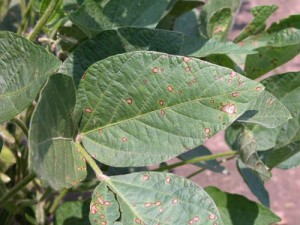Frogeye leaf spot is caused by the fungus Cercospora sojina. Frogeye leaf spot is a major disease of soybean in the south, and has recently expanded into the northern soybean-growing areas. Frogeye leaf spot is most likely to become a problem if infected seed is planted or if the disease occurred in the previous year’s soybean crop and the field is not rotated.
Symptoms
The most diagnostic symptom of frogeye leaf spot are angular spots with light gray centers and distinct purple to red-brown margins. No yellow halos surrounding lesions are present. Leaf spots can be single or merge to form larger lesions. This can result in premature leaf drop.Lesions on stems and pod can occur later in the season, but they are less common and distinctive than lesions on the leaves. Seeds near pod lesions can be infected and develop conspicuous light to dark gray or brown areas.
Disease cycle
Leaf symptoms are first noticeable after plants begin to bloom. Infection and disease spread are greater during warm, humid weather with cloudy days and frequent rain. The fungus produces abundant spores in warm, humid weather, creating cycles of leaf infection throughout the season. Extended periods of wet weather will favor disease development.
The fungus can survive in plant residue or on seeds in storage. Seed infection is common and infected seeds are a means of long distance spread of the fungus. Infected seed germinates poorly and the resulting seedlings are usually weak. Spores produced on the cotyledons of infected seedlings are the main source of inoculum for the leaf phase of the disease.
Management
When scouting soybean fields for weeds and insects, check for foliar diseases. If you suspect frogeye leaf spot, contact your County Extension Agent and have symptomatic plants sent to the UW Plant Diagnostic Clinic.
The most effective control for frogeye leaf spot is avoidance. Avoid introducing the pathogen by planting high quality, pathogen-free seed. If the disease was detected in your crop last year, planting a resistant variety is the most effective management strategy. C. sojina is an extremely variable pathogen with multiple physiologic races. Since we do not know which races are present in Wisconsin; choose a variety with a high level of resistance. Three major dominant genes (Rcs1, Rcs2, and Rcs3) confer resistance to frogeye leaf spot.
Tillage practices that keep plant debris on the soil surface provide a conducive environment for pathogen survival and growth. Therefore, deep plowing of crop residues and two-year rotations with crops other than soybean can lower inoculum levels and reduce disease.
References
First Report of Frogeye Leaf Spot (Cercospora sojina) in Wisconsin. Alemu Mengistu, N. C. Kurtzweil and C.R. Grau. Plant Disease 86:1272, 2002
Yang, X.B, M.D. Uphoff, and S. Sanogo. 2001. Outbreaks of soybean frogeye leaf spot in Iowa. Plant Disease. 85:443.



